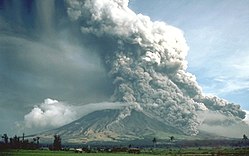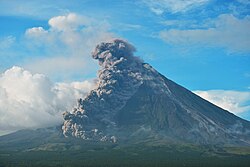Pyroclastic flow
A pyroclastic flow, pronounced pie-roh-class-tick, (also known as a pyroclastic density current) is a flow of hot volcanic gas and tephra, during a volcanic eruption. A cloud forms over the current of hot rock. This boiling column of superheated gas, sand, tephra, obsidian, and pumice can reach soaring temperatures of 1,000 °C (1,800 °F) and its average speed ranges from 100 km/h (30 m/s; 60 mph) to 700 km/h (190 m/s; 430 mph).
They are extremely dangerous and can be deadly. A person cannot outrun a pyroclastic flow. Learn more at USGS.gov.
Pyroclastic Flow Media
Pyroclastic flows sweep down the flanks of Mayon Volcano, Philippines, in 2018
Pyroclastic rocks from the Bishop tuff; uncompressed with pumice (on left), compressed with fiamme (on right)
Building remnant in Francisco Leon destroyed by pyroclastic surges and flows during eruption of El Chichon volcano in Mexico in 1982. Reinforcement rods in the concrete were bent in the direction of the flow.
A scientist examines pumice blocks at the edge of a pyroclastic flow deposit from Mount St. Helens
The casts of some victims in the so-called "Garden of the Fugitives", Pompeii





